Choosing a water filter for your home is exciting, but you might also be overwhelmed with your choices.
Reverse osmosis systems are some of the most popular filters available today, offering a much more thorough, multi-stage filtration process than the average filter.
But reverse osmosis water filters aren’t necessarily the best choice for everyone. In this guide, we’ve shared everything you need to know about the differences between reverse osmosis and normal water filters. By the end, you should be able to choose the best filter type for you.
📌 Key Takeaways:
- Reverse osmosis filters produce purified water by using membrane separation technology.
- Water filters use filter media to trap contaminants, improving water quality.
- Water filters are cheaper and less wasteful than reverse osmosis systems, but they’re not as thorough as RO water filtration.
- A reverse osmosis system is best for people with big budgets who want the most thorough tap water filtration, while a water filter is ideal for people who want to target specific contaminants.
Table of Contents
🆚 Reverse Osmosis Vs Water Filters: Key Differences
Let’s take a look at the key differences between reverse osmosis systems and water filters across several categories:
Filtration Process
Reverse Osmosis:
Reverse osmosis uses a membrane separation filtration process that purifies water.
Most RO systems consist of numerous filter stages, including a sediment pre-filter, an activated carbon filter, a semi-permeable membrane, and a post-carbon filter.
The semi-permeable membrane is where the magic happens. Water is forced through 0.0001-micron pores, while contaminants rebound off the membrane and are removed with a small amount of wastewater.
After it’s treated, RO water is either sent straight out of the dedicated faucet when you turn on the tap, or stored in a tank until it’s needed.
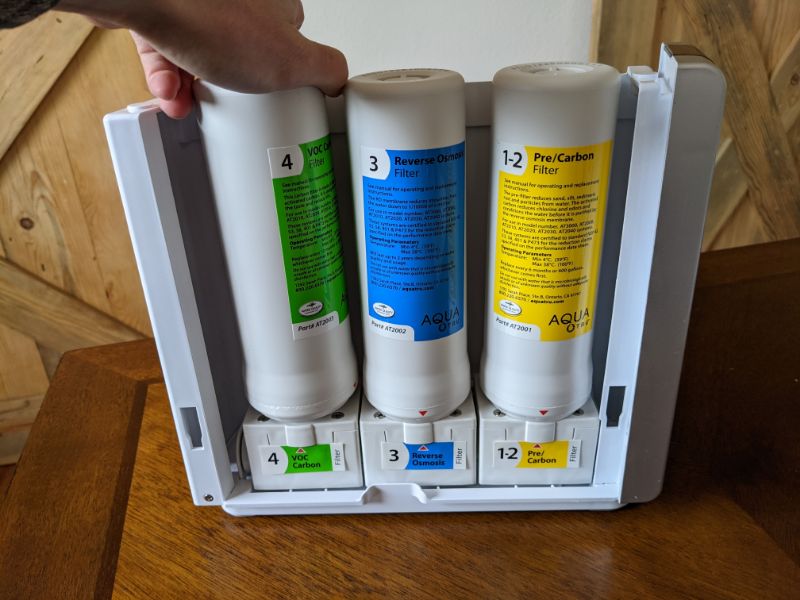
Water Filters:
Water filters typically use a media that traps or grabs contaminants, preventing them from passing through.
This filtration may be caused by chemical reactions (such as activated carbon media, which adsorbs contaminants). Or, the filter, may have small pores or a network of twists and turns, designed to trap contaminants as water flows through.
Some manufacturers sell single-media filter cartridges, while others blend multiple filter media together, like activated carbon and KDF, within the same cartridge. You can also find water filtration systems that combine several separate filter cartridges to increase the contaminant removal potential.
Continue Reading: Carbon filters vs reverse osmosis
Contaminant Removal
Reverse Osmosis:
A reverse osmosis system removes virtually all contaminants from drinking water. Thousands of impurities are repelled by the semi-permeable membrane, including volatile organic compounds (VOCs), chemicals, metals, pesticides, herbicides, pharmaceuticals, and more.
📌 RO systems do what most standard water filters can’t: they remove microorganisms like bacteria. These pathogens are so small that they slip through the pores of an average filter, but they’re too large to pass through an RO membrane.
Plus, an RO membrane rejects minerals and salts, which most filters can’t.
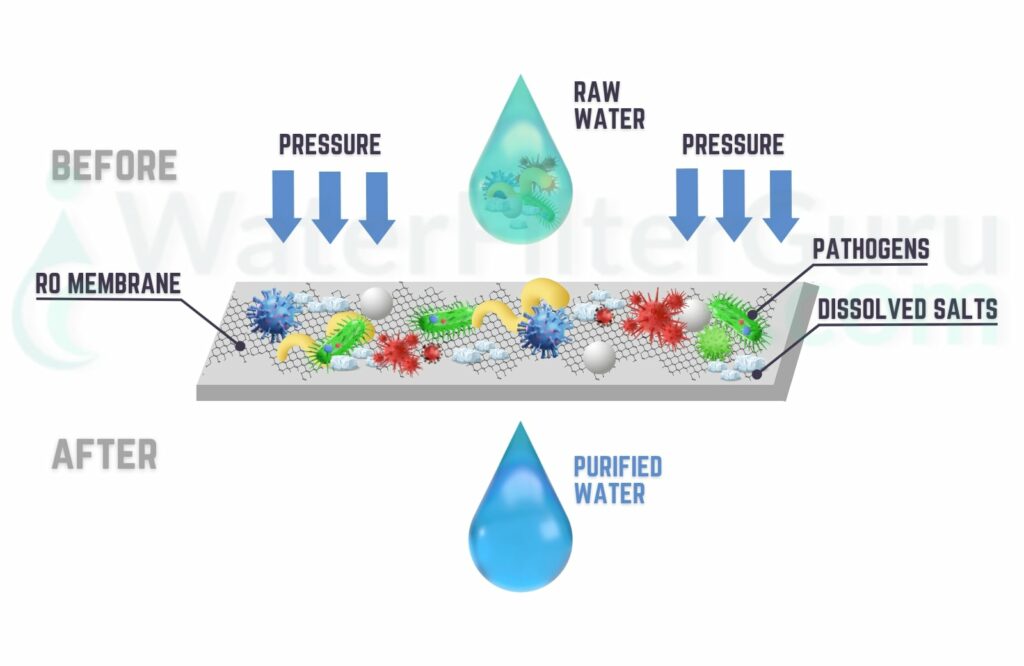
Water Filters:
Different types of water filters reduce or remove different contaminants.
This may include volatile organic compounds, chlorine and chloramine, heavy metals, and other chemicals and pharmaceuticals.
The best water filters can remove hundreds of contaminants from water – just not the thousands of contaminants that an RO system can reduce.
Water filters usually retain healthy minerals in tap water, and they’re not usually capable of reducing microorganisms (with the exception of ceramic filters).
Installation & Maintenance
Reverse Osmosis:
RO systems are installed as under-sink systems, countertop units, or (more rarely) whole home systems.
Installing an RO filtration system is a complex process involving cutting into your water line. Tank-based systems have a large storage tank that needs to be installed downstream of the filtration system. Because the RO process wastes water, you’ll also need to connect the system to your plumbing.
As for maintenance, most RO systems have four separate filter stages. The sediment filter typically lasts 6 months, while the carbon filters last 9-12 months and the semi-permeable membrane lasts about 2 years.
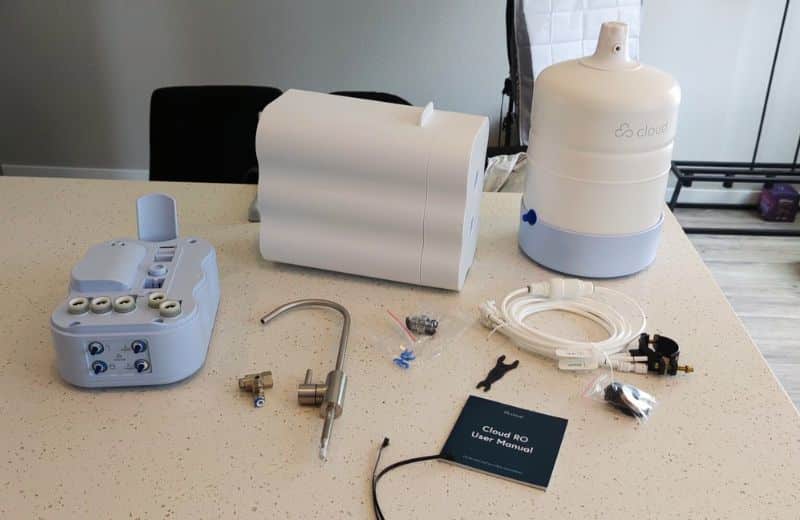
Water Filters:
You have a much bigger selection of water filter types. Some water filters, like pitcher filters, dispensers, countertop filters, and bottle filters, don’t need installing at all – just set them up on your countertop for instant use. If you’re not a fan of DIY, we recommend one of these filters.
Other filters, like under-sink water filtration systems and whole-house filtration system models, need to be installed similarly to an RO filter, directly at your water line.
Maintenance depends on the filter type and size. The small filters in a drinking water pitcher usually need replacing every 2-3 months, while whole-home water filtration systems have an average filter lifespan of 9-12 months onwards.
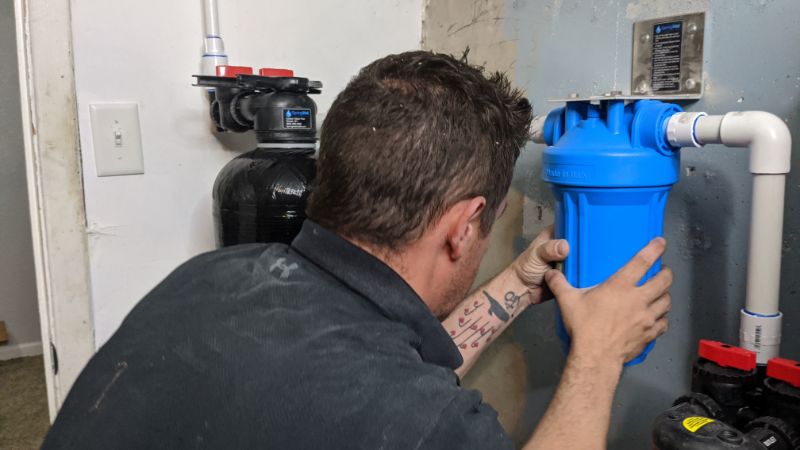
Cost
Reverse Osmosis:
RO systems are complex systems that produce excellent results, which makes them quite expensive to buy upfront.
The average under-sink or countertop RO water filtration system costs $200-$600, while a whole-home drinking water system using RO costs anywhere from $1,000 to $7,500.
The long-term costs of owning an RO system are pretty high, too – about $150 per year – due to the numerous filter changes required.
Water Filters:
Water filters are priced depending on their size and filter stages. The average under-sink water filtration system costs $100-$200, while whole-home systems cost $600-$1,200 or more. The cheapest systems are pitcher filters, fridge filters, and faucet filters, which cost less than $100 upfront.
The long-term cost of owning a water filter is $50-$150 per year, depending on the filter.
Efficiency
Reverse Osmosis:
Water is wasted during the RO process, which means that no RO filter is truly efficient.
Some RO systems are more efficient than others. Traditional RO filters waste 4 gallons of water for every 1 gallon produced. Now, new, more efficient systems have been designed that waste only 1 or 2 gallons of water for every 1 gallon produced.
Water Filters:
Water filters are much more efficient than reverse osmosis filtration systems since they don’t waste water. All the tap water that travels into the filter leaves the filter on the other side.
✔️ Pros and Cons of Water Filters
Here are some of the pros and cons of a standard water filter:
Pros
- They retain healthy minerals
- They’re more affordable than RO
- They don’t waste any water
- They’re cheaper to maintain
- They come in a variety of media types, including carbon filters, KDF and ion exchange media, and more
Cons
- They don’t remove as many contaminants as RO filters
- They often require more maintenance depending on the filter type
- They reduce flow rate somewhat
- They can’t usually reduce bacteria or small microorganisms
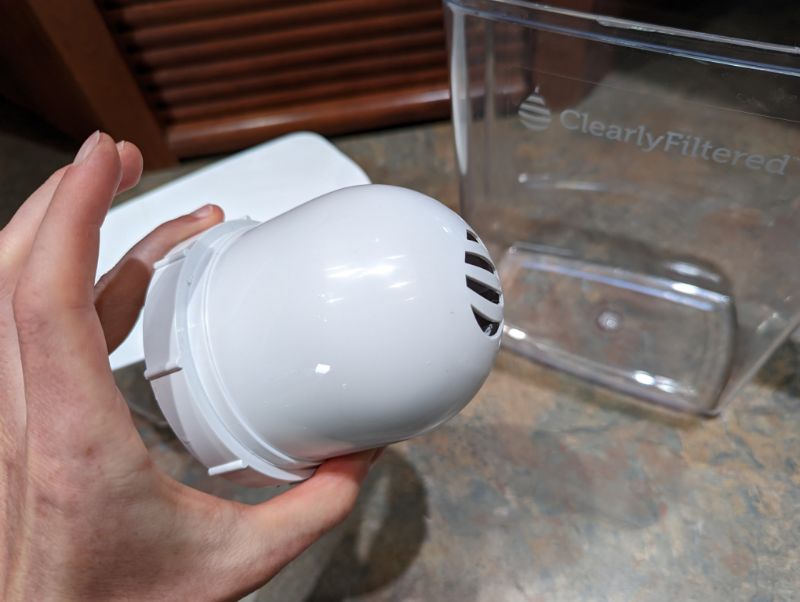
✔️ Pros and Cons of Reverse Osmosis
Below are the pros and cons of owning an RO system:
Pros
- They offer the most thorough drinking water filtration process
- They get rid of everything, including bacteria
- They’re low maintenance, only requiring filter changes every 6-24 months
- There are multiple system types available, including tank-based, tankless, countertop, under-sink, and whole-home
- They improve the taste of water by removing poor-taste and poor-odor contaminants
Cons
- They waste water
- They’re expensive
- They produce a more noticeable pressure drop than a single filter
- They don’t retain healthy minerals
- They may require additional pre-treatment (for water with high TDS)
We’ve discussed more extensively the Pros & Cons to Owning a Reverse Osmosis System here!
👨⚖️ Water Filter Vs Reverse Osmosis: Which Is Best For You?
Now you know the differences between water filters and reverse osmosis, and the pros and cons of both, it’s time to decide which is best for you.
📌 Here’s what we think.
- If you’re prepared to spend a lot of money for the perks of the most thorough water filtration available, and you don’t mind wasting water, a reverse osmosis system is best for you.
- If you have a small budget and you just want to improve your water quality without purifying it, and you prefer to have a greater number of options available (in terms of filter size and application), go for a water filter.
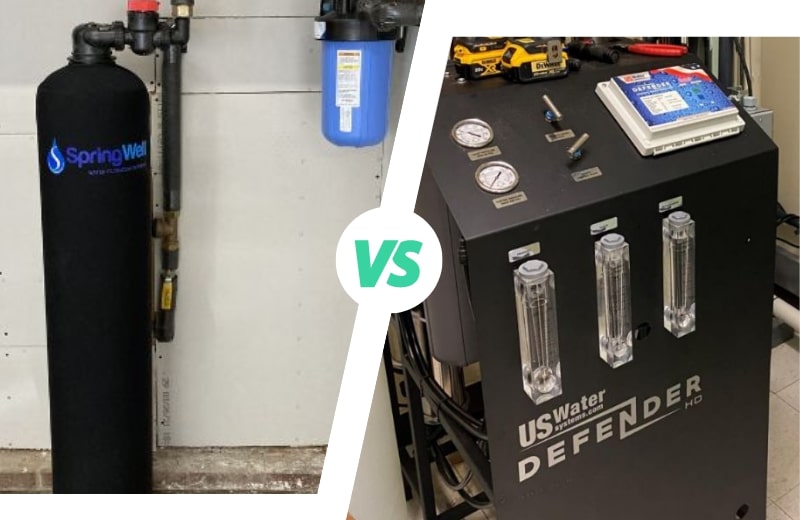
In our eyes, neither reverse osmosis nor water filtration is the clear “best” choice – it depends on your contaminant removal preferences, your budget, and your preferred filter type.
❔ Water Filter Vs Reverse Osmosis: FAQ
Is water from reverse osmosis healthy?
Yes, water from reverse osmosis is healthy because it’s free from unhealthy, unsafe contaminants. However, reverse osmosis water also doesn’t contain minerals or salts, which are found naturally in most tap water supplies and increase the water’s health properties. We need many of the minerals in water to survive, but they’re available much more plentifully in foods.
Is there something better than reverse osmosis?
Since RO removes virtually everything from tap water, there’s nothing better than the reverse osmosis process – but a couple of processes are equal to RO. Ultrafiltration is another water filtration method that has a pore size of 0.002 to 0.1 microns, so it’s similar but not quite as thorough as reverse osmosis. Distillation is another method of complete water purification that some people would argue is better than reverse osmosis because it doesn’t waste water. However, the distillation process takes hours, so it definitely has its own inconveniences.
Which is better reverse osmosis or UV system?
Reverse osmosis is better than UV purification if you just want to remove as many contaminants as possible from your drinking water. Alternatively, if you just want to kill microorganisms without necessarily improving your water quality, a UV filtration system is cheaper and highly effective.
Which is better RO or carbon filter?
If you want to remove as many contaminants as possible from your water, a reverse osmosis water filter is better than a carbon filter. That’s because reverse osmosis removes thousands of contaminants, while even the best carbon filter can only usually remove chlorine, heavy metals, and VOCs. However, if you prefer to drink minerals in your water, and you’re not bothered about complete purification, carbon filters might be best for you.

